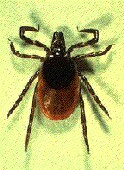
WEDNESDAY, Jan. 16 (HealthDay News) — People who go outdoors in several regions of the United States may have something else to worry about. Scientists report that there’s another troublesome germ hiding in the deer tick that already harbors the Lyme disease bacterium.
There are indications that the germ infects a few thousand Americans a year, potentially causing flu-like symptoms such as fever. In one newly reported case, a woman with existing medical problems appeared to have brain swelling and dementia caused by an infection.
It is not clear, however, how serious of a threat may be posed by the germ. For the moment, Lyme disease appears to be much more prevalent. And four other germs that affect humans lurk in deer ticks.
Still, scientists say the germ is cause for concern. “This would not be commonly picked up by any of the current tests for Lyme disease,” said Victor Berardi, co-author of one of two reports about the germ in the Jan. 17 issue of the New England Journal of Medicine.
The bacterium in question is Borrelia miyamotoi and is found on deer ticks (also known as blacklegged ticks) in parts of the country where Lyme disease is prevalent. In 2011, Russian researchers reported that people there were infected by the bacterium, and the new reports have found that it has infected people in the United States as well.
“We’ve known about this bacterium for a long time — at least 10 years,” said Sam Telford III, a professor of infectious disease at Tufts University in Medford, Mass., who co-authored the report with Berardi. “It’s been under our nose all this time, and a lot of us just ignored it until there was this case report.”
For the most part, Lyme disease infections occur in northeastern states, Wisconsin and Minnesota, and northern California. The germs are spread by ticks that bite the skin and remain there for a day or more.
In the U.S. case, an 80-year-old woman who lived on a farm in New Jersey was infected by the Borrelia miyamotoi germ. She suffered from non-Hodgkin lymphoma (which disrupts the immune system) and developed what appeared to be signs of dementia. She recovered after taking penicillin, and scientists later confirmed that she had been infected with the bacterium and may have developed swelling in the brain and brain lining as a result.
Researchers warned that the germ could be responsible for apparent cases of dementia in older people, especially those who suffer from conditions such as AIDS, which weaken the immune system. The germ also appears to cause fever, headache, chills and sweats, among other symptoms.
So how common might infection with the germ be?
Another new report in the journal found signs of B. miyamotoi infection in blood tests taken from people in New York and New England between 1990 and 2010. They were treated with the antibiotics doxycycline and amoxicillin, which are cheap and unlikely to have serious side effects, said lead author Dr. Peter Krause, a senior research scientist at the Yale School of Public Health in New Haven, Conn.
He estimates that 4,000 to 5,000 cases of the disease may appear in the United States each year, compared with 30,000 of Lyme disease.
There is no test for the germ yet, but researchers are working on one. It should cost about $100, said Berardi, who also is an associate director of laboratory science at Imugen, a Norwood, Mass., company that develops medical tests.
More information
For more about Lyme disease, try the U.S. National Library of Medicine.

